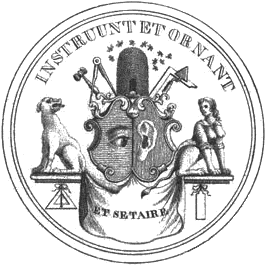Great Mother Lodge of the Eclectic Freemasons Association
The Great Mother Lodge of the Eclectic Freemasons Association was one of the eight regular Freemasons - Grand Lodges that existed in the German Reich until 1935 . It was founded in Frankfurt am Main in 1741 and dissolved in 1933. It was most widespread in 1933 with 3500 members in 24 lodges. After 1945 it was not reactivated; their 14 remaining lodges were among the founding members of the Grand Lodge of the Old Free and Accepted Masons of Germany in 1949 .
history
After the end of the Strict Observance at the all in all unsuccessful convent in Wilhelmsbad in 1782, the German Freemasons looked for alternatives to the "Templar errors" of their time. This means attempts to establish Freemasonry as a direct successor to the medieval Knights Templar . One of these alternatives was the L'Union Lodge in Frankfurt am Main, which was run by Johann Peter Gogel in the style of the Grand Lodge of England , i.e. with three degrees without high degrees. Gogel was Provincial Grand Master of the Grand Lodge of England. The L'Union had received an English patent in 1743 and there was a contract between the Grand Lodge (GLL) and the Grand Lodge of England that the L'Union should join the GLL after Gogel's death. The lodge brothers showed little interest in it.
The establishment of the Eclectic League was primarily driven by Franz Dietrich von Ditfurth from Wetzlar . He had been Prefect (Provincial Grand Master) in the Strict Observance, but was disappointed with the system. Together with the Frankfurt brothers, he brought about the connection between these two provinces. A circular from Ditfurths, together with the Frankfurt senator and lodge master Johann Karl Brönner, dated March 18, 1783 came at a time when new, esoteric, alchemical and downright occult new Masonic rituals were emerging, especially from France, a call to return to the simple ones Roots the same. Although little attention was paid to it at the beginning, by 1789 fifty-three lodges from Germany, Poland, Naples and Denmark joined the Eclectic Freemasons' Union . The name comes from the suggestion to take the best out of all systems and develop a new teaching system from it. The federal government issued a uniform body of law in 1788.
The covenant brothers soon tried to get back in touch with England. Certainly the accusation of practicing Illuminatiism instead of Freemasonry was a reason to adhere clearly to the English humanitarian three-degree system . On October 25, 1789, Johann Peter von Leonhardi was appointed Provincial Grand Master. Grand Master von Ditfurth then withdrew from active lodge life and resigned from office in 1791.
Many lodges were closed during the Napoleonic Wars , and at the time of the French occupation in 1793, the Confederation struggled to maintain its independence. In the occupied territories, Napoleon usually asked the lodges there to join the Grand Orient de France , which he controlled , in which a relative of his had been appointed Grand Master. The work was temporarily stopped completely until 1808.
The work under the Grand Lodge of London was of little use to the brothers of the eclectic league, as London, contrary to existing treaties, founded lodges in Frankfurt and also violated other parts of the treaty. Under the leadership of Leonhardi, the brothers founded an independent grand lodge from the Bund in 1823, which they called the Great Mother Lodge of the Eclectic Freemasons Association. Second grandmaster was Georg Franz Burkhard Kloß in 1836 . Although all member boxes were free to process high grades, knight games, superstition, astrology and obscurantism of all kinds were deliberately declared a fight.
In 1811 they gave themselves a Christian ritual. The eclectic federation rejected the high degrees and only processed the Royal Arch degree, a high degree from England with Old Testament references. In 1844 the Christian principle was abandoned again, which is why some lodges left the grand lodge and founded their own grand lodge ( Great Masonic Lodge "Zur Eintracht" ). In 1859/60 the Hessian lodges of the Eclectic League had to open the grand lodge by order of Ludwig III. leave and join the Great Masonic Lodge "Zur Eintracht".
Presumably it disbanded in March 1933 under pressure from the Nazi authorities; there does not seem to be any precise files.
The ritual of the Eclectic Freemasons Association is still being worked on today by lodges in Hamburg (“Zur Brudertreue an der Alster”) and in Frankfurt.
Known members
- Franz Dietrich von Ditfurth (1738–1813)
- Karl Oppel (1816–1903)
- Jakob Mauvillon (1743–1794)
- Karl Friedrich Bahrdt (1740–1792)
- Georg von Wedekind (1761–1831)
- Georg Franz Burkhard Kloß (1787-1854)
literature
- Karl Oppel : Purposefully and with united strength. The Great Mother Lodge for the centenary of the Eclectic Federation, March 18, 1883. Frankfurt am Main 1883 ( digitized version )
- Eugen Lennhoff / Oskar Posner: International Freemason Lexicon . Almathea-Verlag Munich 1980, reprint from 1932, ISBN 3-85002-038-X
- Helmut Neuberger: Angle measure and swastika: The Freemasons and the Third Reich . Herbig Verlag, Munich 2001, ISBN 3-7766-2222-9
- Ferdinand Runkel: History of Freemasonry . Hobbing, Berlin, 3 vol., Reprint: Edition Lempertz, Bonn 2006, ISBN 3-933070-96-1

